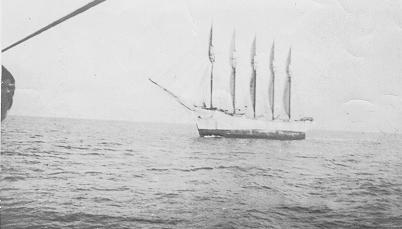Carroll A. Deering Shipwreck – The Mystery That Endures

There is nothing left of the Carroll A. Deering now. After the 5-masted schooner ran aground at Diamond Shoals on January 31, 1921 the Coast Guard, after examine the wreck, towed and dynamited it, concerned about a threat to shipping.
But its presence can still be felt, for the Deering is one of the most baffling mysteries in maritime history.
Because of weather conditions, the Coast Guard was unable to board the vessel for five days. What was found perplexed the crew boarding her and left the FBI and other investigators searching for answers.
The lifeboats had been launched and there was no sign of the crew. The ship itself was in good shape; however, the ship’s log, navigational equipment, personal belongings and documents were all gone. There was no sign of a struggle, except in the captain’s quarters—dinner was on the stove but the cabin was in chaos, perhaps suggesting a struggle.
Built by the GG Deering Company of Bath, Maine and launched in 1919, the ship was the last the company would build and was named for the son of the owner. Although well into the age of steamships, large sailing ships like the Deering were more economical for coastal trade, and the legs of its ill-fated 1921 journey began August of 1920 in Norfolk where it picked up a load of coal for delivery to Rio de Janeiro.
Soon after leaving port, the ship’s master, Captain Merritt becomes ill. The ship docked in Lewes Delaware, where it is determined he is too sick to continue. His son and first mate, S.E. Merritt, stays with his father in Delaware.
Charles Wormell, a well-respected ship’s master with years of experience, is then hired as captain, and and Charles McLellan is hired as first mate.
The ship continues to Rio where it unloads its cargo and the crew of 11 goes ashore. While ashore, Captain Wormell sees an old friend, a Captain Goodwin, and in the course of conversation tells him he doesn’t trust his first mate, believing he is a trouble maker.
Wormell’s concerns seem well-founded. When the Deering puts into Barbados for supplies and shore leave in early January, First Mate McLellan gets drunk and is thrown in jail. Wormell bails him out, but witnesses describe an argument that takes place later in which McLellan threatens the Captain’s life.
On January 9, the ship leaves Barbados and is not seen again until the 29th when the crew hails lightship keeper Captain Jacobson aboard the Cape Lookout Lightship, telling him the ship had lost its anchors in a gale and to notify the Deering Company, owner of the ship.
The Lightship’s radio is out, so Jacobson is unable to contact anyone immediately. He does report in his ship’s log though, “5 mast schooner Carrol A. Deering, in passing bound North, reported having lost both anchors and chains off Frying Pan Shoal, asking to be reported, but ship’s wireless out of commission. Was unable to get in touch with passing vessels.”
Testimony taken later from Jacobson seemed to be an indication that something was not quite right on the Deering. According to what he told investigators, at the time the ship hailed him the entire crew seemed to be gathered on the foredeck. Perhaps most significantly the man he spoke to, based on Jacoboson’s experience, neither spoke nor acted like an officer.
Two days later the Carroll A. Deering was found abandoned on Diamond Shoals.
The Coast Guard salvage crew that boarded the ship found additional mysteries, beyond the pristine shape of the vessel. A map indicating daily positions of the ship showed Captain Wormell’s distinctive handwriting until January 23. After that date, someone else was recording the positions. Before abandoning the ship, the crew did take the time to place red warning lights on the masts, indicating the ship was derelict or out of control.
The investigation was unable to resolve what happened.
Most mariners at the time felt mutiny was the most likely cause, although no sign of the lifeboats nor any member of the crew has ever been accounted for.
Other possibilities included piracy at the hands of Bolshevik inspired American Communists and rum runners, since this was the age of prohibition.
Both theories have been largely discounted. As a sailing vessel, the Deering was too slow and too visible to be a rumrunner; piracy would have involved seizing the ship and that clearly did not happen.
The mystery endures, and it may never be solved.
